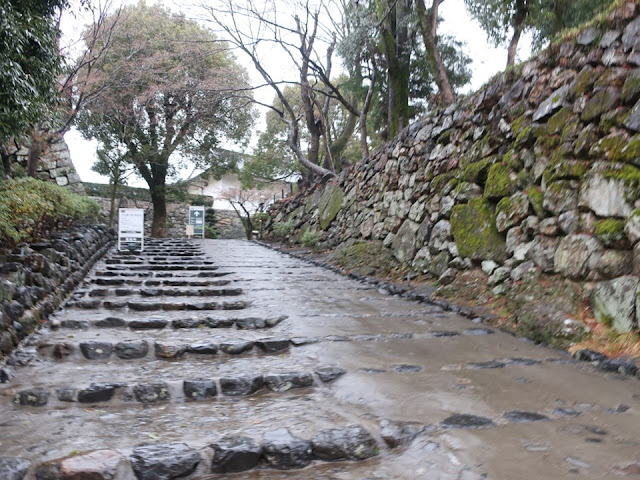Inuyama City is north of Nagoya in central Japan. It has Inuyama Castle which is a national treasure designated by Japanese government. Because only twelve castle towers have remained; Inuyama Castle is the oldest one. The castle was a symbol of han (local government) in the Edo period (1603~1868). Citizens would be proud of it.
Japan was a federation in which each han
controlled their territory in the Edo period. People loved their castle town
where was not only political center but also economical and cultural center;
a big festival was held there. The video in the museum how people love the city
even until now. It is very important to love our city in order to lead a happy
life.
Let’s see Inuyama Castle at first!
We can see the castle tower at the end of the main street. There are many shops along the street including old ones. It’s a nice sightseeing destination. It is rare that the blocks are same as the one in the Edo period.
城下のメインストリート・本町通りの先に犬山城の天守が見えます。店が多く古い家も残っていて素敵な観光地ですね。江戸時代の町割が残っている場所は珍しいそうです。
犬山市は、人口七万人強、名古屋の北にあります。城下はこぢんまりした街ですが、犬山城が見えて、市民の皆さんの誇りになっていると思います。日本の現存天守閣は12、犬山城は最古であり、国宝に指定された5城の一つです。
江戸時代の日本では、各藩が治政の権利を持ついわば連邦国家です。人々は藩の中心地、城下町を大切にしました。犬山も商業と文化の拠点で、祭りも育ててきました。祭りの映像展示を見ていると、今でも市民の皆さんが街を愛していることがよく分かりました。住んでいる場所を愛せることは、楽しい人生を過ごす上でとても大切なことです。まずは、犬山城から紹介します。
Inuyama Castle、犬山城
We climb the stone steps to the castle tower.
お城には石の階段を登って行きます。
The Inuyama Castle was built in 1537. During the Battle of Komaki Nagakute, Toyotomi Hideyoshi, who was the most powerful war lord at that time, entered the castle and fought against Tokugawa Ieyasu who was a founder of Edo Bakuhu (shogunate) in 1584. There is a line of visitors on holidays.
犬山城は、1537年に織田信長の叔父・信康が築城したそうです。小牧長久手の戦い(1584年)には秀吉が入城し本拠としました。休みの日は、入城待ちの行列ができます。
A steep staircase to the 1st floor.
1階への階段。急ですね。
The 1st floor is pretty large, and it has a lord’s room.
1階には上段の間があります。まずまず広いです。
We can see the Ieyasu’s troop headquarters (Komaki) from the south-facing window. Hideyoshi took 120,000 soldiers along; he must have observed Ieyasu’s troop from here. On the other hand, in the peaceful Edo period, the lord probably enjoyed the scenery of his castle town and territory.
城の南側には家康が布陣した小牧山が見えます。秀吉は12万の兵を率いて、緊張感を持ってこの景色を見ていたはずです。江戸時代には、街を一望できるこの場所は、正に殿様気分に浸れるところだったと思います。
There are mountains and Kiso River on the north side, which were natural strongholds. A scholar named the castle Haku(white)-Tei(emperor)-Jou(castle) which was quoted from the poem of Li Po (701-762, Chinese poet).
城の北側は木曽や飛騨へと続く山地、東側には木曽川が流れ天然の要害になっています。荻生徂徠は李白の詩を引いて「白帝城」と呼びました。川の向こうは美濃国、こちらは尾張国です。今も県境です。
Haritsuna Shrine which holds Inuyama Festival is at the foot of the castle. It was moved from the castle town to the castle site in 1882.
今は城山にある針綱神社の祭礼は、有名な犬山祭です。明治15年に城下から遷座されました。
Shiro to Machi museum (Inuyama Artifacts Museum)、城とまちミュージアム(犬山市文化史料館)
The museum is next to the castle site. It was a chief retainer’s residence. It's a nice museum, because it shows us not only the castle and samurai but also the castle town and inhabitants.
城山を降りるとすぐの場所にあります。元は、家老の屋敷地だったそうです。城と武士だけでなく、街と庶民を紹介している素敵な史料館です。
We can take photos only in this hall. The panels behind the model of the castle town introduce the castle and the daimyo lord in the Edo period. Inuyama-han was a branch of powerful Owari-han (I’ll introduce its luxurious palace later). Naruse clan ruled the Inuyama-han.
撮影できるのはホールだけで、ちょっと残念ですが、その内容はタップリ。街のジオラマの奥のパネルでは、城と武家を紹介しています。犬山藩3万5千石の成瀬氏は、尾張藩の付け家老(藩主の補佐役)も兼ねていました。
The one to 200th scale model of the castle town shows Inuyama Festival in 1840. The floats parade on the main street. Inuyama people like the festival so much.
ホール中央の城下町の模型(1/200)では、本町通りを犬山祭の車山(やま)が通過していて何とも楽しいです。1840年8月28日(旧暦)の犬山祭本楽を再現しています。大垣の人々はこの祭を愛しています。
The models of floats are exhibited. There is a doll on a top of the float, which can perform. The float changes of direction in very unique way called “Donden”. I’ll show it in the section of Donden museum (part2 of this article).
車山の模型も展示されています。最上段にはからくり人形を載せています。また、方向転換は「どんでん」という力業で行います。詳細は、パート2の「どんでん館」で紹介します。
The inhabitants’ lives are shown in the panels. The market opened five days a month. People in the rural areas came and it was a busy market like the picture on the panel (upper right). Specialties were also presented to a shogun in Tokyo. Those were alcoholic beverage for medicinal purposes and ayu fishes pickled in sake lees. The beverage is sold even until now.
Water-transportation was an important industry. Lumbers of Kiso mountains were checked in Inuyama and delivered to the downstream such as Nagoya. These activities caused Inuyama prosperous.
街の暮らしはパネルで紹介されています。市が立つ日(月に五日)には、五里十里離れた村からも人が来て、パネルのような大変な賑わいだったそうです。特産物の葱苳酒(にんど、うしゅ、スイカズラの薬用酒)と粕漬鮎は将軍家の献上品でもありました。葱苳酒は今も販売されています。
そして、水運。木曽の山から切り出された木は、犬山で検査を受け、下流に向かいました。これらが犬山に富をもたらせたのですね。
We cannot take photos inside the exhibition room. Exhibits related to the daimyo lord are displayed in the room 1.
ここから先は撮影禁止です。藩主・成瀬家ゆかりの品などが展示されていました。
In the exhibition room 2, people’s lives are shown. There is a replica of a shop and merchant utensils are exhibited. A wooden utensil on the right of the photo was used to make pressed sushi during Inuyama festival and so on. As far as I recall, the ingredients were saba fish, lotus root, dry baked wheat gluten (fu) and so on.
街の暮らしでは、帳場が再現されていて、商家の道具などが展示されていました。粕漬鮎の作り方などもあります。写真奥、左側の展示品は押し寿司を作る道具です。犬山祭などハレの日に、鯖の他にレンコンや角麩も材料にすると書いていたと思いました。あやふやですみません。
Visited in
January, 2022
Official
website:
Inuyama
Castle/犬山城 https://inuyamajo.jp/
(in English), https://inuyama-castle.jp/
(in Japanese、very interesting movie (outside and inside of the castle) are on this website、城内外の動画付きでおすすめです)
Shiro to Machi museum (Inuyama Artifacts Museum)、城とまちミュージアム(犬山市文化史料館) https://www.city.inuyama.aichi.jp/kurashi/bunka/1001052/1001054/1001055.html
(in Japanese)
accessed
in Jun, 2022
Previous
post (Cormorant fishing museum in Gifu City which is near Inuyama) :
Juhachiro in Gifu、岐阜市・十八楼
Next
post (Part2 is about Inuyama festival): Inuyama
Castle and museums(2/2)、犬山城と城下の資料館(2/2)
















Comments
Post a Comment